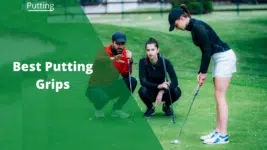Just the other day, I was teaching my children how to read a putting green, and it dawned on me what a huge difference it makes when a player knows how to read a green. Think about it. You can have a perfect putting stroke, use the right equipment, aim directly at the hole with just the right speed, and still miss a putt.
As a former PGA professional, I can tell you that most golfers struggle with reading greens. This guide will help you understand the best way to read greens and the steps you should take each time you need to make a putt.
How To Read A Green At A Glance
If you are in a hurry, here are the top green reading tips. We will explain each of these in greater detail so you can see how they will impact your game and what you should do to incorporate them into your next round of golf. Here’s how to read greens:
- Read the entire green as you approach the area
- Do a complete walk around your putt
- Squat down to get a better look before doing anything else
- Use your feet and feel to see if there is any slope
- Stay vigilant and learn from others in the group
- Learn to read the grain of your putts so that you can make more putts
Green Reading Tips & Techniques

These green reading tips are great, but if you really want to get better at reading greens, you need to learn green reading techniques and develop a putting routine that includes them. Let’s look at how to read golf greens so that your next round includes a few fewer putts.
Read The Green As You Approach
When learning how to do anything, the more information you can acquire, the better your chances are of developing the skill and using it to the best of your advantage. If you have a seven-foot putt to read, it’s challenging to only give yourself seven feet of information.
Instead, as you walk up to the green, start looking at the entire picture. From further away, you will be able to see the slope of the whole green and the way your ball will likely flow when you hit the putt.
Reading the entire green and the surrounding areas gives your brain more clues as to what the golf ball will do when you make contact.
Take A Lap Around Your Putt
Standing behind your putt and looking at the break is good, but you can learn more when you walk around the entire putt. If you watch professional golfers, they almost always do a complete lap around their putt to ensure that they see and understand the full picture.
In addition, as you are walking to the hole, your brain is calculating the distance needed to sink your putt. This helps you improve distance control and gives golfers a better chance of making a putt.
The lap around your putt lets you see the slope from all angles and increases the likelihood of you making the putt.
Squat Down Before You Do Anything Else
Before making your way around the hole to read the entire putt, it’s best to take an initial glance at the putt that you have in front of you. To read the green properly, you should squat down behind your ball and look at the path the ball will need to take to get to the hole.
Golfers can certainly read too much into a putt and end up overthinking this entire process. When you start by just squatting down and taking an initial look, you start to develop your idea of what the putt will likely do.
Chances are, this initial read will be very close to the final read. Golfers should learn to trust their instincts when it comes to reading putts.
Become One With The Green
This may be a little philosophical for some golfers, but it is very important to start learning from your feet and body as you move around the greens. If you can feel yourself walk down towards the hole or feel a slight slope up as you move back to your ball, you can add these bits of information into your putting knowledge.
For those that have a hard time seeing what the green will do, feeling what the green does is just as important.
Always Be Learning
Although watching other golfers while they are putting is polite, smart players learn from what other golfers are doing. If you watch another player’s putt head towards the hole and it takes an unexpected turn, you can use this information to decide what to do with your putt.
When learning how to read a green, you must remember that the line you choose will impact the ball’s speed. If you hit the ball harder, you can take more of a direct route to the hole as it will not be impacted by the break quite as much.
For golfers that hit the ball softly, you may have to play a lot more break so that the ball can take this route and end up near the hole. Learning from the other golfers in your group will help you combine what you know about speed and break to hopefully make a few more putts.
Reading Grain 101
Reading the grain on a green can be really important at some golf courses. The grain will impact the speed of the putt. Essentially a putt going down grain will have a higher speed than a putt going against the green.
Reading grain will require a player to look at the coloration of the putting green.
- If the green is shiny or lighter in color, you are likely putting down grain.
- If the green is dull or darker in colors, you are likely putting into the grain.
Some golf greens are grainier than others. If you are playing on a grainy green and forget to account for the grain, you can miss your putt. If your home course has grainy greens, take a lesson with the local professional and get some specific tips from that professional. This information could help you save a few strokes on your next round.
Not An Exact Science
It is important to remember that reading greens is not an exact science. Putting is a combination of several different skills that all come together to get the ball in the hole. As we mentioned reading the green is extremely important, but if you don’t get the speed right or aim the club improperly, it won’t matter much that you had a perfect read.
The best putters are those that feel comfortable on the putting green. There is no denying that spending time on putting greens and learning to read greens will help you get better. Practice going to various holes on a putting green and see which way the ball will flow and turn.
Like any other golf skill, you will need to practice green reading. You’ll also want the best equipment that fits your swing.
Read more: We reviewed the best putters on the market this year so you can find the perfect fit.
Ways To Practice Reading Greens

Now that you have a better idea of how to read greens, you may be wondering how to practice these techniques. Here are a few of our favorite drills and ideas.
Indoor Putting Practice
You won’t have to go to the driving range or the golf course to work on your putting green, instead purchase an indoor putting green that has some break and perfect your green reading skills all winter long. The bigger the indoor putting green, the better!
No Two Putts Are The Same
When you head to the practice green to work on reading greens, stop bringing three golf balls with you. Instead, bring one ball and putt it to a different hole each time. This means that you will have to read each individual putt and learn how the green turns and moves.
If you use the same ball with the same hole repeatedly, you are really just practicing your stroke, not your green reading.
Experiment with Speeds
Many players will have luck with reading a little less break and getting the ball to the hole at a slightly faster pace. Others like to be more conservative with a putt and read into the break a little more. Set up to a hole on a putting green that has a fairly significant break. Try putting at a few different speeds and see how it impacts the break.
FAQs

Here are a few of the most commonly asked questions about how to read greens and the best green reading techniques out there. Understanding this information can really help you become a better golfer.
How Do Pros Read Greens?
Pros read greens using the same techniques we described above. They will approach the hole and scan the entire area. Then the pros will spend time bending down to get an initial read. Finally, they walk around the entire putt to get a look at this from a few different angles.
Most pros will announce to the caddy what they think the putt will do, and sometimes they will look at their notebook that has information about previous rounds and observations that they have made that week.
At this point, the caddy will typically give the green light, and the player then trusts their line and their putting stroke to get it done.
How Do You Read a Green for Beginners?
Beginners should focus on the basics at first when learning how to putt. Certain things like reading the green and paying attention to the ball breaking away from the mountains or towards the water may be a bit much to handle.
With a beginner, it is important to look at whether the putt is up or downhill and if the putt looks as though it will turn left or right. Once these considerations are made, the speed will need to be adjusted to match the chosen line, then the putt can be hit.
Beginners also need to pay close attention to the alignment. If you have a perfect read but don’t know how to line up a putt, the result will not be favorable.
How Do You Read Golf Greens for Speed and Break?
Learning how to read putting greens for both speed and break takes some time and dedication. One of the things that golfers should decide on early in their career is whether or not they want to be a firm putter that is a bit more aggressive or a softer putter that lets the green move the ball.
Stick with a consistent speed and putting stroke to learn how to read the break appropriately. Golfers who know they hit putts firm can focus on a smaller break. When a golfer is said to have a great feel, one of the things they do best is combining the speed and break of a putt to have a really impressive result.
Can You Lay Down on the Green To Read a Putt?
Some golfers like to lay down on the green to get the information they need about their putt. Truthfully, this is not necessary. Even though golfers are allowed to do this, you could damage the green, and the information collected will not even be all that valuable.
Final Thoughts
Knowing how to read greens can save you a few strokes each round, and it’s worth practicing these drills. To review our green reading methods:
- Look at the green from afar as you walk up
- Walk around your putt
- Squat down to look at your putt
- Notice what your feet feel as you walk
- Watch other putts
- Pay attention to grain from green to green
But you don’t have the right putter, reading a green could not be that helpful.
Read more: We’ve reviewed the best putters on the market today, as well as the best putters for women. If you’re on a budget, our reviews of the best putters under $100 could help you.
Britt is a Class A PGA Professional and golf membership director who decided a career in golf writing was the perfect fit. She's been playing golf since she was seven years old, graduated from St. John's University with a bachelor's degree in education, and played Division 1 golf with a +1 handicap. Today, Britt plays more golf than ever with her husband and two children near Savannah, Georgia, and still loves connecting with golfers worldwide. You can connect with Britt on IG, LinkedIn, or FB.







